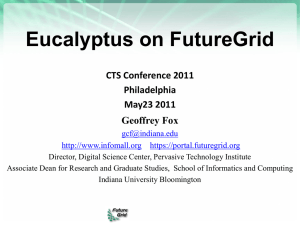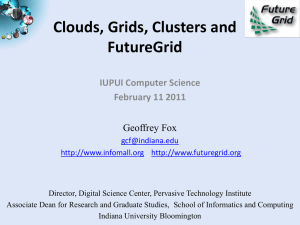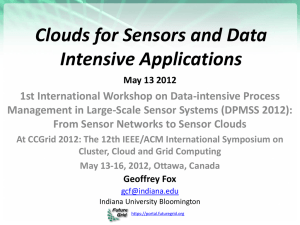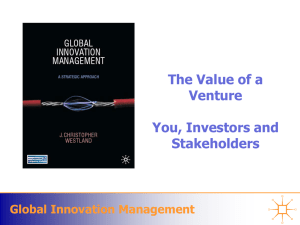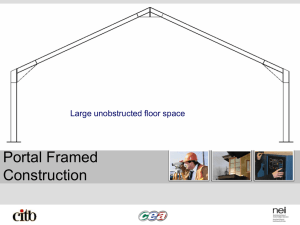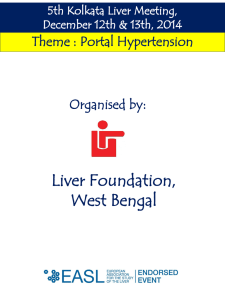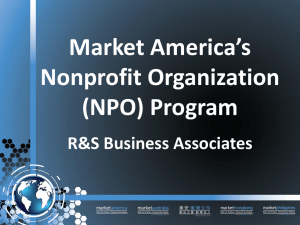Fox_Talk - NSF PI Meeting
advertisement
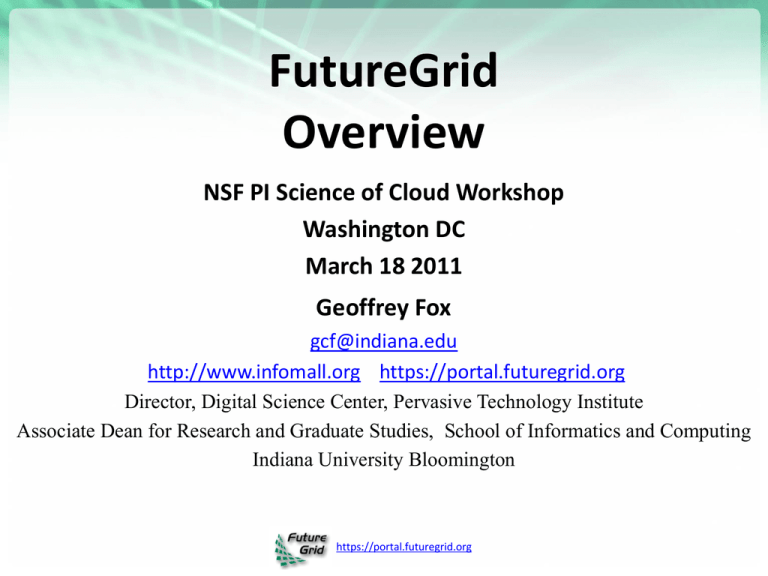
FutureGrid Overview NSF PI Science of Cloud Workshop Washington DC March 18 2011 Geoffrey Fox gcf@indiana.edu http://www.infomall.org https://portal.futuregrid.org Director, Digital Science Center, Pervasive Technology Institute Associate Dean for Research and Graduate Studies, School of Informatics and Computing Indiana University Bloomington https://portal.futuregrid.org US Cyberinfrastructure Context • There are a rich set of facilities – Production TeraGrid facilities with distributed and shared memory – Experimental “Track 2D” Awards • FutureGrid: Distributed Systems experiments cf. Grid5000 • Keeneland: Powerful GPU Cluster • Gordon: Large (distributed) Shared memory system with SSD aimed at data analysis/visualization – Open Science Grid aimed at High Throughput computing and strong campus bridging https://portal.futuregrid.org 2 FutureGrid key Concepts I • FutureGrid is an international testbed modeled on Grid5000 • Supporting international Computer Science and Computational Science research in cloud, grid and parallel computing (HPC) – Industry and Academia • The FutureGrid testbed provides to its users: – A flexible development and testing platform for middleware and application users looking at interoperability, functionality, performance or evaluation – Each use of FutureGrid is an experiment that is reproducible – A rich education and teaching platform for advanced cyberinfrastructure (computer science) classes https://portal.futuregrid.org FutureGrid modeled on Grid’5000 • Experimental testbed – Configurable, controllable, monitorable • Established in 2003 • 10 sites – 9 in France – Porto Allegre in Brazil • ~5000+ cores http://futuregrid.org 4 FutureGrid key Concepts II • FutureGrid has a complementary focus to both the Open Science Grid and the other parts of TeraGrid. – FutureGrid is user-customizable, accessed interactively and supports Grid, Cloud and HPC software with and without virtualization. – FutureGrid is an experimental platform where computer science applications can explore many facets of distributed systems – and where domain sciences can explore various deployment scenarios and tuning parameters and in the future possibly migrate to the large-scale national Cyberinfrastructure. – FutureGrid supports Interoperability Testbeds – OGF really needed! • Note much of current use Education, Computer Science Systems and Biology/Bioinformatics https://portal.futuregrid.org FutureGrid key Concepts III • Rather than loading images onto VM’s, FutureGrid supports Cloud, Grid and Parallel computing environments by dynamically provisioning software as needed onto “bare-metal” using Moab/xCAT – Image library for MPI, OpenMP, Hadoop, Dryad, gLite, Unicore, Globus, Xen, ScaleMP (distributed Shared Memory), Nimbus, Eucalyptus, OpenNebula, KVM, Windows ….. • Growth comes from users depositing novel images in library • FutureGrid has ~4000 (will grow to ~5000) distributed cores with a dedicated network and a Spirent XGEM network fault and delay generator Image1 Choose Image2 … ImageN https://portal.futuregrid.org Load Run Dynamic Provisioning Results Total Provisioning Time minutes 0:04:19 0:03:36 0:02:53 0:02:10 0:01:26 0:00:43 0:00:00 4 8 16 32 Number of nodes Time elapsed between requesting a job and the jobs reported start time on the provisioned node. The numbers here are an average of 2 sets of experiments. https://portal.futuregrid.org FutureGrid Partners • Indiana University (Architecture, core software, Support) • Purdue University (HTC Hardware) • San Diego Supercomputer Center at University of California San Diego (INCA, Monitoring) • University of Chicago/Argonne National Labs (Nimbus) • University of Florida (ViNE, Education and Outreach) • University of Southern California Information Sciences (Pegasus to manage experiments) • University of Tennessee Knoxville (Benchmarking) • University of Texas at Austin/Texas Advanced Computing Center (Portal) • University of Virginia (OGF, Advisory Board and allocation) • Center for Information Services and GWT-TUD from Technische Universtität Dresden. (VAMPIR) • Red institutions have FutureGrid hardware https://portal.futuregrid.org FutureGrid: a Grid/Cloud/HPC Testbed NID: Network Impairment Device Private FG Network Public https://portal.futuregrid.org Compute Hardware # CPUs # Cores TFLOPS Total RAM (GB) Secondary Storage (TB) Site IBM iDataPlex 256 1024 11 3072 339* IU Operational Dell PowerEdge 192 768 8 1152 30 TACC Operational IBM iDataPlex 168 672 7 2016 120 UC Operational IBM iDataPlex 168 672 7 2688 96 SDSC Operational Cray XT5m 168 672 6 1344 339* IU Operational IBM iDataPlex 64 256 2 768 On Order UF Operational 128 512 5 7680 768 on nodes IU New System TBD 192 384 4 192 PU Not yet integrated 1336 4960 50 18912 System type Large disk/memory system TBD High Throughput Cluster Total https://portal.futuregrid.org 1353 Status Storage Hardware System Type Capacity (TB) File System Site Status DDN 9550 (Data Capacitor) 339 Lustre IU Existing System DDN 6620 120 GPFS UC New System SunFire x4170 96 ZFS SDSC New System Dell MD3000 30 NFS TACC New System Will add substantially more disk on node and at IU and UF as shared storage https://portal.futuregrid.org FutureGrid: Online Inca Summary https://portal.futuregrid.org FutureGrid: Inca Monitoring https://portal.futuregrid.org 5 Use Types for FutureGrid • ~100 approved projects over last 6 months • Training Education and Outreach – Semester and short events; promising for non research intensive universities • Interoperability test-beds – Grids and Clouds; OpenGrid Forum OGF really needed this • Domain Science applications – Life science highlighted • Computer science – Largest current category (> 50%) • Computer Systems Evaluation – TeraGrid (TIS, TAS, XSEDE), OSG, EGI • Clouds are meant to need less support than other models; FutureGrid needs more user support ……. https://portal.futuregrid.org 14 Some Current FutureGrid projects I Project VSCSE Big Data Institution Educational Projects Details IU PTI, Michigan, NCSA and Over 200 students in week Long Virtual School of Computational 10 sites LSU Distributed Scientific Computing Class LSU Topics on Systems: Cloud Computing CS Class IU SOIC Science and Engineering on Data Intensive Applications & Technologies 13 students use Eucalyptus and SAGA enhanced version of MapReduce 27 students in class using virtual machines, Twister, Hadoop and Dryad OGF Standards Interoperability Projects Virginia, LSU, Poznan Sky Computing University of Rennes 1 https://portal.futuregrid.org Interoperability experiments between OGF standard Endpoints Over 1000 cores in 6 clusters across Grid’5000 & FutureGrid using ViNe and Nimbus to support Hadoop and BLAST demonstrated at OGF 29 June 2010 Some Current FutureGrid projects II Domain Science Application Projects Combustion Cummins Cloud Technologies for Bioinformatics Applications IU PTI Performance Analysis of codes aimed at engine efficiency and pollution Performance analysis of pleasingly parallel/MapReduce applications on Linux, Windows, Hadoop, Dryad, Amazon, Azure with and without virtual machines Cumulus Computer Science Projects Univ. of Chicago Differentiated Leases for IaaS University of Colorado Application Energy Modeling UCSD/SDSC Use of VM’s in OSG Open Source Storage Cloud for Science based on Nimbus Deployment of always-on preemptible VMs to allow support of Condor based on demand volunteer computing Fine-grained DC power measurements on HPC resources and power benchmark system Evaluation and TeraGrid/OSG Support Projects Develop virtual machines to run the OSG, Chicago, Indiana TeraGrid QA Test & Debugging SDSC TeraGrid TAS/TIS Buffalo/Texas https://portal.futuregrid.org services required for the operation of the OSG and deployment of VM based applications in OSG environments. Support TeraGrid software Quality Assurance working group Support of XD Auditing and Insertion 16 functions Typical FutureGrid Performance Study Linux, Linux on VM, Windows, Azure, Amazon Bioinformatics https://portal.futuregrid.org 17 OGF’10 Demo from Rennes SDSC Rennes Grid’5000 firewall Lille UF UC ViNe provided the necessary inter-cloud connectivity to deploy CloudBLAST across 6 Nimbus sites, with a mix of public and private subnets. https://portal.futuregrid.org Sophia Education & Outreach on FutureGrid • Build up tutorials on supported software • Support development of curricula requiring privileges and systems destruction capabilities that are hard to grant on conventional TeraGrid • Offer suite of appliances (customized VM based images) supporting online laboratories • Supported ~200 students in Virtual Summer School on “Big Data” July 26-30 with set of certified images – first offering of FutureGrid 101 Class; TeraGrid ‘10 “Cloud technologies, data-intensive science and the TG”; CloudCom conference tutorials Nov 30-Dec 3 2010 • Experimental class use fall semester at Indiana, Florida and LSU; follow up core distributed system class Spring at IU • Offering ADMI (HBCU CS depts) Summer School on Clouds and REU program at Elizabeth City State University https://portal.futuregrid.org 300+ Students learning about Twister & Hadoop MapReduce technologies, supported by FutureGrid. July 26-30, 2010 NCSA Summer School Workshop http://salsahpc.indiana.edu/tutorial Washington University University of Minnesota Iowa IBM Almaden Research Center Univ.Illinois at Chicago Notre Dame University of California at Los Angeles San Diego Supercomputer Center Michigan State Johns Hopkins Penn State Indiana University University of Texas at El Paso University of Arkansas University of Florida https://portal.futuregrid.org FutureGrid Tutorials • • • • • • • • • Tutorial topic 1: Cloud Provisioning Platforms Tutorial NM1: Using Nimbus on FutureGrid Tutorial NM2: Nimbus One-click Cluster Guide Tutorial GA6: Using the Grid Appliances to run FutureGrid Cloud Clients Tutorial EU1: Using Eucalyptus on FutureGrid Tutorial topic 2: Cloud Run-time Platforms Tutorial HA1: Introduction to Hadoop using the Grid Appliance Tutorial HA2: Running Hadoop on FG using Eucalyptus (.ppt) Tutorial HA2: Running Hadoop on Eualyptus • • • • • • • • • • • Tutorial topic 3: Educational Virtual Appliances Tutorial GA1: Introduction to the Grid Appliance Tutorial GA2: Creating Grid Appliance Clusters Tutorial GA3: Building an educational appliance from Ubuntu 10.04 Tutorial GA4: Deploying Grid Appliances using Nimbus Tutorial GA5: Deploying Grid Appliances using Eucalyptus Tutorial GA7: Customizing and registering Grid Appliance images using Eucalyptus Tutorial MP1: MPI Virtual Clusters with the Grid Appliances and MPICH2 Tutorial topic 4: High Performance Computing Tutorial VA1: Performance Analysis with Vampir Tutorial VT1: Instrumentation and tracing with VampirTrace https://portal.futuregrid.org 21 Software Components • • • • • • • • • • Portals including “Support” “use FutureGrid” “Outreach” Monitoring – INCA, Power (GreenIT) Experiment Manager: specify/workflow “Research” Image Generation and Repository Intercloud Networking ViNE Above and below Virtual Clusters built with virtual networks Nimbus OpenStack Performance library Eucalyptus Rain or Runtime Adaptable InsertioN Service for images Security Authentication, Authorization, Note Software integrated across institutions and between middleware and systems Management (Google docs, Jira, Mediawiki) • Note many software groups are also FG users https://portal.futuregrid.org FutureGrid Layered Software Stack User Supported Software usable in Experiments e.g. OpenNebula, Kepler, Other MPI, Bigtable https://portal.futuregrid.org http://futuregrid.org • Note on Authentication and Authorization • We have different environments and requirements from TeraGrid • Non trivial to integrate/align security model with TeraGrid 23 Rain in FutureGrid https://portal.futuregrid.org 24 From Dynamic Provisioning to “RAIN” • In FG dynamic provisioning goes beyond the services offered by common scheduling tools that provide such features. – Dynamic provisioning in FutureGrid means more than just providing an image – adapts the image at runtime and provides besides IaaS, PaaS, also SaaS – We call this “raining” an environment • Rain = Runtime Adaptable INsertion Configurator – Users want to ``rain'' an HPC, a Cloud environment, or a virtual network onto our resources with little effort. – Command line tools supporting this task. – Integrated into Portal • Example ``rain'' a Hadoop environment defined by an user on a cluster. – fg-hadoop -n 8 -app myHadoopApp.jar … – Users and administrators do not have to set up the Hadoop environment as it is being done for them https://portal.futuregrid.org 25 FG RAIN Command • • • • fg-rain –h hostfile –iaas nimbus –image img fg-rain –h hostfile –paas hadoop … fg-rain –h hostfile –paas dryad … fg-rain –h hostfile –gaas gLite … • fg-rain –h hostfile –image img • Authorization is required to use fg-rain without virtualization. https://portal.futuregrid.org Image Creation • Creating deployable image – – – • • Image gets deployed Deployed image gets continuously – • User chooses one base mages User decides who can access the image; what additional software is on the image Image gets generated; updated; and verified Updated; and verified Note: Due to security requirement an image must be customized with authorization mechanism – – – – – limit the number of images through the strategy of "cloning" them from a number of base images. users can build communities that encourage reuse of "their" images features of images are exposed through metadata to the community Administrators will use the same process to create the images that are vetted by them Customize images in CMS https://portal.futuregrid.org 27 FutureGrid Viral Growth Model • Users apply for a project • Users improve/develop some software in project • This project leads to new images which are placed in FutureGrid repository • Project report and other web pages document use of new images • Images are used by other users • And so on ad infinitum ……… https://portal.futuregrid.org http://futuregrid.org 28 Create a Portal Account and apply for a Project https://portal.futuregrid.org 29
